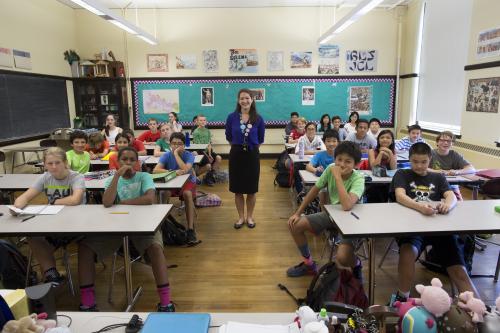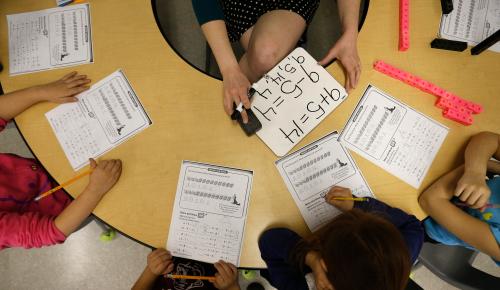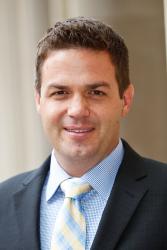This post is part of “Teacher diversity in America,” a series from the Brown Center on Education Policy that examines minority underrepresentation among public educators in the U.S.
The beginning of a new school year often prompts renewed interest in the diversity of the public teacher workforce, and this year is no different. Minority teachers count for less than 20 percent of all public school teachers, while minority students account for roughly half of all students. And, troublingly, this trend is not likely to reverse anytime soon, based on our report on the topic last year.
There are myriad factors that appear to contribute to the systemic underrepresentation of minority teachers, as well as a variety of proposed solutions to reduce these gaps. Experimenting with these types of policies should be worth it, as the weight of research evidence shows that disadvantaged students stand to benefit most from a more diverse workforce.
Yet, in our perspective, we need to know much more about the diversity gap and what it looks like to better understand how best to tackle it. This is the first post in a series focused on the diversity of the public teacher workforce that we will be publishing over the coming months on the Brown Center Chalkboard. We hope this series will shed new light on the nature of the diversity gap as we probe it from different angles. We begin this series by exploring the diversity gap in detail, exploring how it varies across different school and teacher characteristics, and what this may say about the diversity gap moving forward.
Except for the section of this post that looks across different sectors, all of the analyses here look at public school teachers only, both traditional public teachers and charter school teachers. We compute the total share of minority teachers and minority students in the corresponding contexts to calculate the diversity gap—defined as the percentage-point difference in representation between the two. Though diversity gaps are present across all racial groups of students and teachers, we focus on the two major non-white racial/ethnic groups in the data: blacks and Hispanics.
Diversity gaps across locales
As a starting point, we examine the share of minority teachers and students by school locale. The analyses presented here utilize data from the 2011-12 Schools and Staffing Survey (SASS), a nationally representative survey of teachers. Figure 1 shows the share of black and Hispanic teachers and students across urban, suburban/town, and rural locales.

It should come as no surprise that these figures show minority groups—both students and teachers—are heavily concentrated in urban areas, and are then less populous in suburban/town and rural locales. However, it may be surprising to see how much larger the diversity gaps are for Hispanics than for blacks—Hispanics are a larger share of the student population in all locales, and Hispanic educators are a roughly equal or smaller share of the teacher population.
Interestingly, the smallest Hispanic diversity gap shown here (among rural schools) is only slightly smaller than the largest black diversity gap (in urban schools). Though much of the research literature on student-teacher matching, which motivates some of the interest in teacher diversity gaps, focuses on black students and black teachers, the continued demographic growth of Hispanic students (and, to a lesser extent, Hispanic teachers) has received relatively little fanfare from researchers. Clearly, more work needs to be done to better understand the Hispanic student and teacher experience.
Diversity gaps by school sector
Minority students and teachers are not only concentrated in urban settings, they are also more likely to be in charter schools (see Figure 2). Though the diversity gaps between students and teachers there are still the largest we see across sectors. This is probably not surprising, given the concentration of charter schools in urban centers. Interestingly, the charter diversity gap is slightly larger for blacks (in comparison to the black urban diversity gap in Figure 1), while the gap for Hispanics is slightly smaller, though these movements appear to be due largely to where minority students go to school rather than where minority teachers take jobs.
Some analysts have posited that a decline of minority teachers in large urban school districts over the past decade has been due in part to the rise of charter schools in these areas. Evidence from the Albert Shanker Institute studying nine school districts generally corroborates that story. Yet, on a national scale, we see the charter teacher workforce as slightly more diverse. In further analyses of the data (omitted for brevity), we compared the demographics of students and teachers in charters against nearby traditional public schools and did see a narrowing of the differences between traditional public and charter schools, though the charter teacher workforce was still slightly more diverse. Thus, we do not see clear evidence of charters whitening the workforce playing out broadly (though it may certainly be happening in certain localities).

Diversity gaps among teacher generations
The demographics of the teacher workforce have evolved over time, and looking at how the diversity gap plays out across different generations can provide insight into where the diversity gap may be heading. With the SASS data, we observed three generations of teachers in America’s pre-K–12 schools, Baby Boomers (those born before 1965, constituting 39 percent of the national teacher sample), Generation X (born between 1965 and 1979, comprising 39 percent), and millennials (born in 1980 or after, comprising 22 percent).
Figure 3 shows teachers of color are not evenly distributed across these generations and, worryingly, both Hispanics and blacks appear to be losing ground among the youngest millennial generation in comparison to Generation X.[1] Since alternative entry in to the teaching profession tends to be a more common entry point for minority teachers, the teacher workforce may get slightly more diverse as the millennial generation ages. Yet, the black teacher trend is concerning, as there appears to be a downward trend in representation across all three teacher generations.

Millennials are a generation worth paying particular attention to because they will be the ones leading the classrooms of tomorrow. If we focus specifically on millennial teachers, as shown in Figure 4, and look at where they’re teaching across the workforce, it’s clear that they are drawn disproportionately to areas where charter schools are located. Unfortunately, charters also have particularly high turnover rates, and hence may also be a leak through which diverse public teachers disproportionately seep out of the system.

How might the diversity gap evolve over time?
Overall, the teacher workforce has trended toward diversity over the last several decades, though these figures cast doubt on whether this trend will continue. President Trump’s top priority in education is expanding school choice, and states are actively pursuing school choice efforts. How choice expands, however, may have important implications for the classroom experience of minority students and teachers (and the diversity gap).
Figure 2 suggests the classroom experience of students who gain greater access to schools will be very different (from a diversity perspective) depending on whether choice expands through offering vouchers to attend private schools or through opening more public charter schools. If the expansion of school choice primarily reaches economically disadvantaged students (and therefore, students who are more likely to be minorities), then private school vouchers would likely result in an infusion of minority students into relatively white schools with predominantly white teacher workforces.
Expansion through charters, on the other hand, would likely result in minority student exposures to minority teachers roughly similar to what they are already experiencing in traditional public schools. Moreover, Figure 4 suggests charters may be somewhat more attractive for young teachers, and as charters expand, we might see teacher hiring in that sector that could bring more minorities into the profession, though this is speculation at this point.
Exactly how the diversity gap will evolve over time is unclear. Yet, given the demographic trends in the country, and the value of minority teachers to minority students, it’s not a trend we can afford to ignore.
Footnote
- We cannot explicitly link teachers to students with the data, and since younger and older teachers are in the same school buildings, we have no reliable way to parse the student demographics across teacher generations. As a result, we simply report the same overall student population statistics across all three teacher generations.








Commentary
Teacher diversity gaps and their evolution under Trump
September 29, 2017